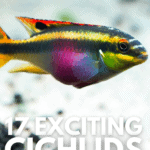Cichlids are one of top picks for fish enthusiasts around the world. There are multiple types of cichlids ranging in size, color, and region of origin – this diversity is what makes this fish so special and interesting to keep.
Many people may steer clear of cichlids as they are known to have an aggressive temperament. However, there are many non-aggressive cichlids that would make great additions to community tanks. There are even types of cichlids that can live together!
As is the case with any type of fish, research and diligence is key in making sure that your cichlids thrive in their new homes. Here are a few tips to get you started!
17 Amazing Cichlid Species for Your Aquarium
1. Angelfish
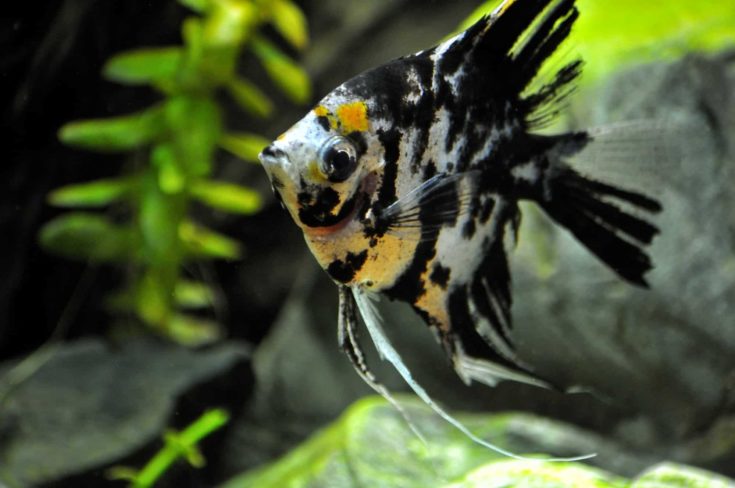
Scientific Name: Pterophyllum scalare
Difficulty level: Moderate
Temperament: Timid
Tank Size: 30 gallons
Diet: Omnivorous
Origin: Amazon
Angelfish hail from South America, and have a preference for slow-moving waters and well-planted tanks with lots of hiding spots. They are relatively easy to care for, but require stable water conditions as they do not handle fluctuations well.
Compared to other cichlids, the Angelfish has a more timid personality. However, it has a penchant for chasing after younger and smaller fish, which is why Angelfish should be introduced to their tank mates at a young age.
To keep angelfish happy, house them in a longer tank to accommodate their flat, elongated bodies. In the wild, these fish obtain the vast majority of their fiber from their diets, so make sure to feed them a balanced mix of plants and protein.
2. Electric Blue Cichlid
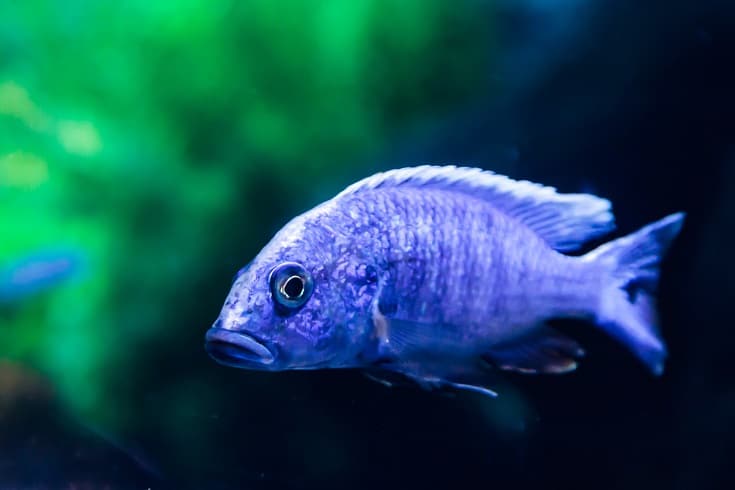
Scientific Name: Sciaenochromis fryeri
Difficulty level: Easy to Moderate
Temperament: Semi-Aggressive
Tank Size: 60 gallons
Diet: Carnivorous
Origin: Lake Malawi, Africa
The electric blue cichlid is stunning and beautiful, but is not typically suited for community tanks because of its semi-aggressive nature.
It is best to keep these species in groups containing 1 male and more than 4 females. Having more than 1 male may cause aggression between males, and having too few females may cause breeding-related stress.
As is the case with most fish from Lake Malawi, the electric blue cichlid is susceptible to Malawi bloat. As such, it is important to feed them specially formulated cichlid pellets and other good-quality protein sources such as brine shrimp.
3. Discus Fish
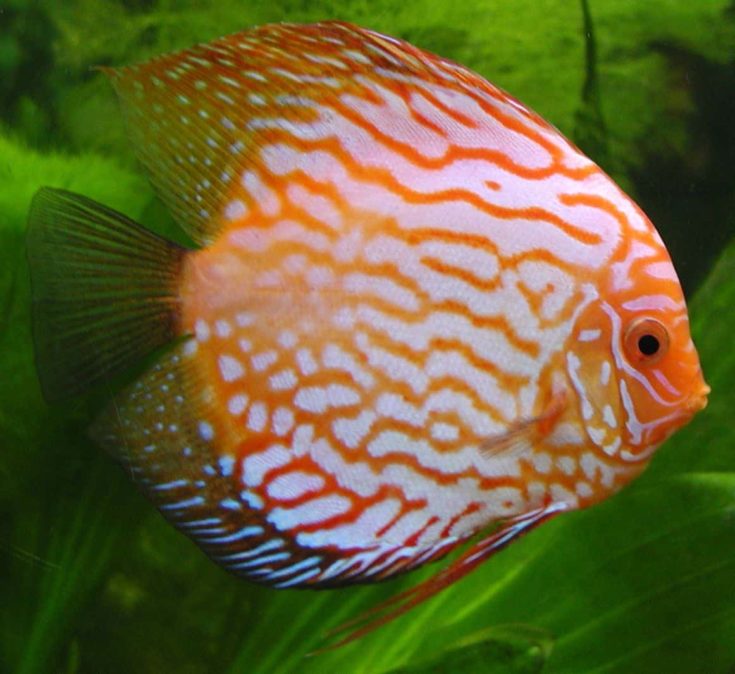
Scientific Name: Symphysodon
Difficulty level: Difficult
Temperament: Peaceful
Tank Size: 55 gallons (for a school of 5)
Diet: Omnivorous
Origin: Amazon
Known as the King of the Aquarium, discus are one of the most popular cichlid varieties because of their bright colors and distinctive, flattened shape.
Discus fish are peaceful fish that should be kept in schools. Because of their flat body shape, they also require tanks with a weak water flow. Ensure that you have a mechanism in place to break the water flow of your tank.
Though discus fish do well in community tanks, they require a higher temperature than most tropical fish in order to minimize the risk of illnesses. The water should also be slightly acidic to replicate their natural habitats.
4. Convict Cichlid
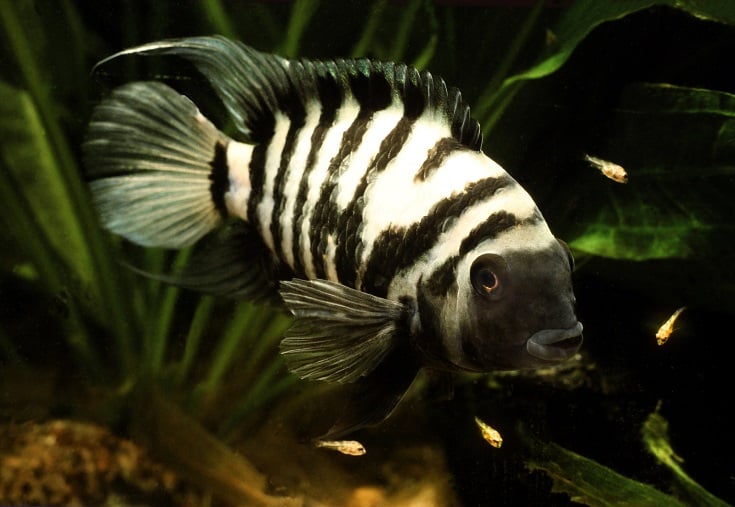
Scientific Name: Amatitlania nigrofasciata
Difficulty level: Moderate
Temperament: Aggressive
Tank Size: 30 gallons
Diet: Omnivore
Origin: South America
Named after the black and white stripes that line its body, the convict cichlid is also sometimes referred to as the zebra cichlid.
Because of their feisty personalities, these are not fish that do well in community tanks. Be that as it may, they are extremely hardy fish – making them perfect for beginners as long as they are housed separately.
In general, territorial fish require larger-sized tanks to minimize aggression. 30 gallons suffices for a pair of cichlids, but 50 gallons is recommended for a larger school.
5. Peacock Cichlid
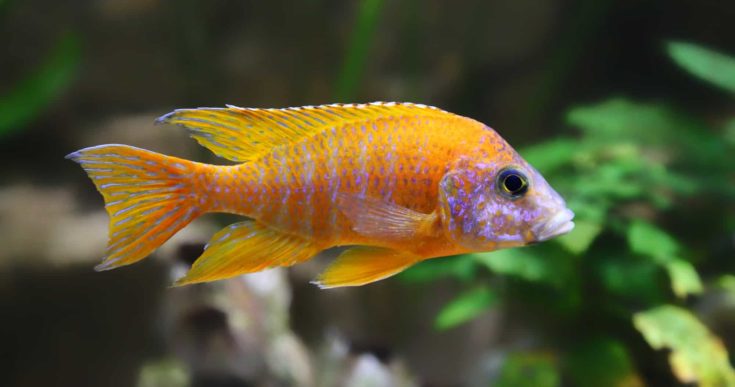
Scientific Name: Cichla ocellaris
Difficulty level: Easy
Temperament: Semi-Aggressive
Tank Size: 55 Gallons
Diet: Omnivore
Origin: Lake Malawi
Colorful and entertaining to watch, the iridescent Peacock Cichlid is one of the most colorful cichlids. These stunning fish hail from Lake Malawi and have a preference for slightly alkaline water conditions of between pH 7.8 – 8.6.
Peacock cichlids routinely sift through sand for food and hover above it to keep a lookout for potential prey. To protect their gills as they sift through the substrate, steer clear of pebbles with jagged edges.
The great news for aquarists hoping to house peacock cichlids in a community tank is that these are generally tame, peaceful fish. Just be sure to maintain a ratio of 1 male to 4 female fish to minimize breeding-related aggression!
6. Cockatoo Cichlid
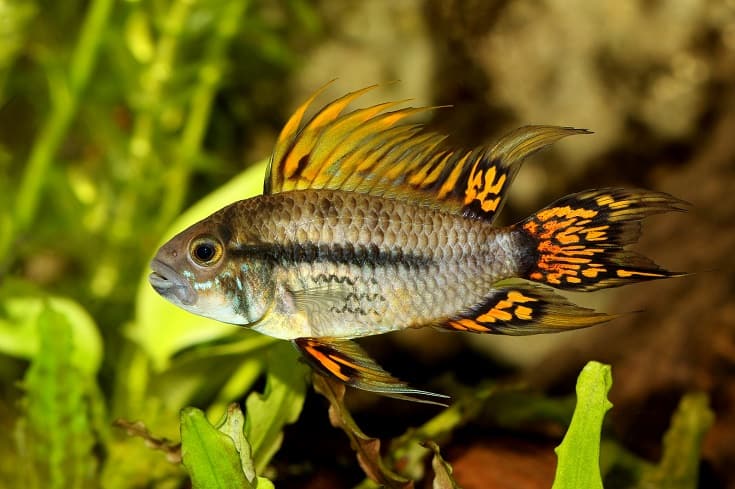
Scientific Name: Apistogramma cacatuoides
Difficulty level: Beginner
Temperament: Peaceful
Tank Size: 20 gallons
Diet: Carnivore
Origin: South America
With a name like that, it comes as no surprise that the Cockatoo cichlid has multiple color variations that range from bright yellow to dark red. This trait, along with their compact size, friendly disposition, and ease of care makes this fish a great pick for any aquarist.
The cockatoo cichlid is a dwarf cichlid that measures between 2-3 inches long. Unlike larger cichlids, they do not uproot plants. They are also fond of hiding – creating caves and other crevices in your tank will make these tiny fish very happy.
Another interesting trait is the prevalence of sneaker males – males that do not develop their full coloration until a more dominant male dies. This protects weaker males from their stronger, more aggressive counterparts.
7. Yellow Lab Cichlid
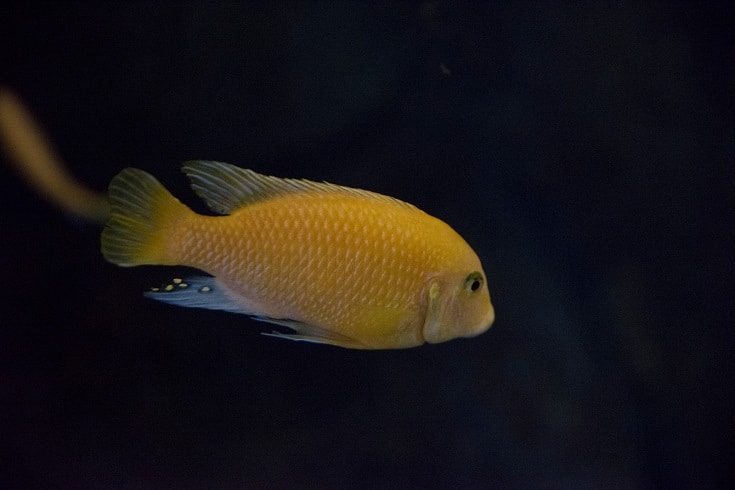
Scientific Name: Labidochromis caeruleus
Difficulty level: Easy
Temperament: Peaceful
Tank Size: 30 gallons
Diet: Omnivorous
Origin: Lake Malawi
Also known as the electric yellow cichlid, the yellow lab cichlid is a go-to for hobbyists looking to introduce a pop of color to their freshwater tanks. Their easy-going temperament adds to their appeal, though they may still act aggressively towards fish of a similar shape and color.
As mouthbrooders, yellow lab cichlids are rather interesting to watch. Female fish will care for their fry even after they’re born, allowing them to seek shelter in their mouths until they grow large enough.
8. Oscar Cichlid
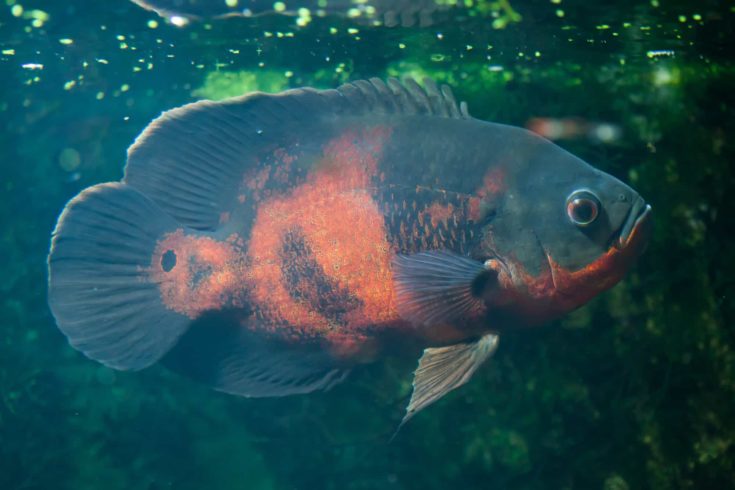
Scientific Name: Astronotus ocellatus
Difficulty level: Moderate
Temperament: Aggressive
Tank Size: 55 gallons
Diet: Omnivorous
Origin: South America
Oscars are interesting, intelligent, large cichlids that can grow up to 12 inches long. With proper care, Oscars can live up to 20 years. They are also resilient and omnivorous, making them easy to care for.
Because of their size, they tend to be messier and require larger tanks than most fish. An oscar tank should be at least 55 gallons, with 30 more gallons for every additional fish.
These fish are also territorial, which means that they should be kept in a dedicated oscar tank. Tank conditions should replicate those of their natural habitat in the Amazons. The water should be kept neutral, while the base of the tank should be lined with a soft substrate.
9. Kribensis Cichlid
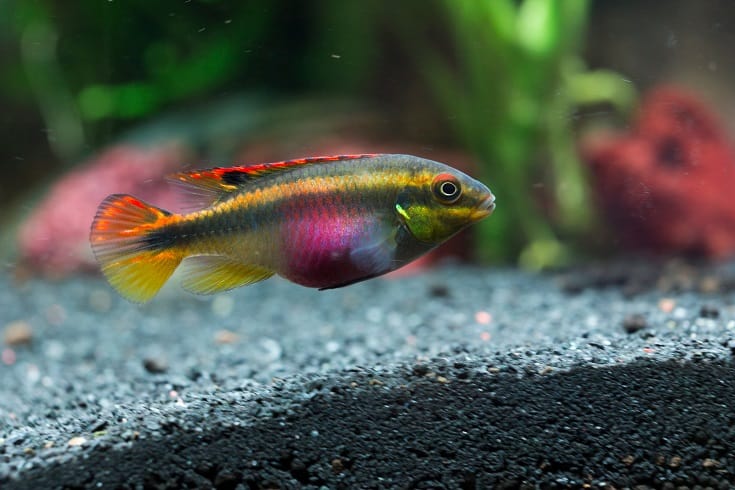
Scientific Name: Pelvicachromis pulcher
Difficulty level: Easy
Temperament: Peaceful
Tank Size: 20 gallon
Diet: Omnivore
Origin: Ethiope River
Kribensis cichlids are one of the smallest cichlids you will encounter as they belong to the dwarf family. Approximately 3 inches long, they come in many colors ranging from blue to pink to yellow, making them popular additions to community tanks.
Kribensis cichlids are tolerant of most water conditions, but these cave-dwellers require caves to feel truly at home. The tank should also be well-planted as these fish enjoy burrowing and may uproot plants.
These fish are mostly peaceful, but may have a tendency to nip at longer-finned fish. They can also be territorial towards other cave-dwelling fish. Avoid other bottom-dwellers and long-finned fish to minimize instances of aggression.
10. Venustus Cichlid
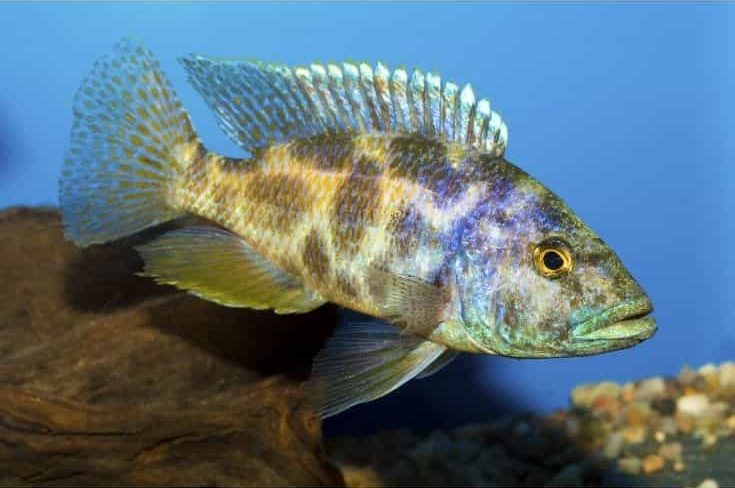
Scientific Name: Nimbochromis venustus
Difficulty level: Moderate
Temperament: Aggressive
Tank Size: 125 gallons
Diet: Omnivorous
Origin: Lake Malawi
Venustus, or giraffe cichlids are large cichlids that can grow up to 10 inches long and require large tanks to accommodate their size and territorial personality. Hailing from Lake Malawi, these fish have a preference for hard water with an ideal pH of 8.0.
Because of their aggressive personalities, these fish should be kept in a species-only tank, with a ratio of one male to several females to minimize breeding-related aggression. Avoid housing males together unless you have a very large tank.
Kept in ideal water conditions, these fish will eat most foods and breed easily. Frequent water changes are an absolute must for these large fish, especially as the alkaline conditions of the water increases the toxicity of ammonia.
11. Frontosa Cichlid
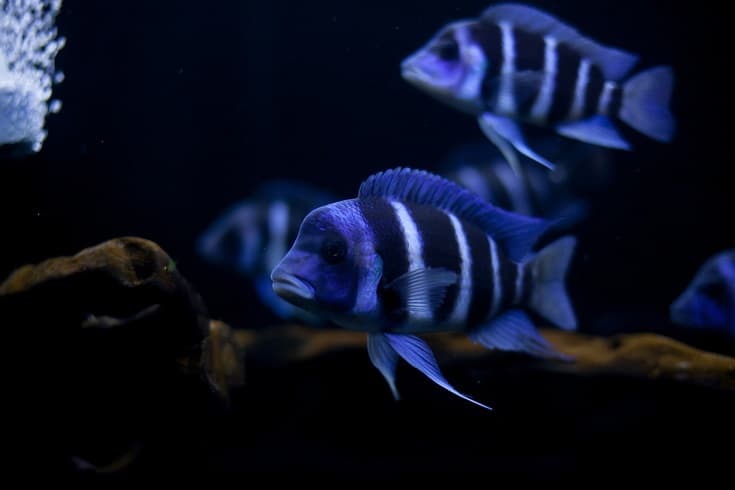
Scientific Name: Cyphotilapia frontosa
Difficulty level: Intermediate
Temperament: Mildly aggressive
Tank Size: 70 gallons
Diet: Carnivorous
Origin: Lake Tanganika, Africa
Sometimes known as the humphead cichlid, frontosa cichlids have a distinctive appearance that makes them the centerpiece of every aquarium it finds itself in. These large cichlids can grow up to 14 inches long, and feature a distinctive bump in front of its head.
In spite of their large size, these are gentle fish that will do reasonably well in community tanks. Just be sure to keep small fish away, as carnivorous frontosas will readily gobble them up as a snack.
These fish are happiest when they are kept in schools of 8-12 individuals in a ratio of 1 male to 4 females. Make sure to house them in a large tank – 75 gallons suffices for a single individual, but 200 gallons is recommended for groups.
12. Firemouth Cichlid
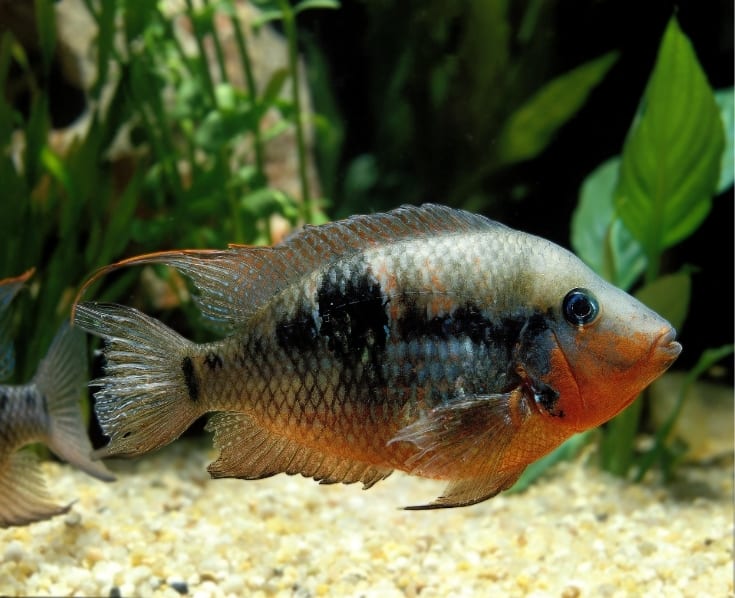
Scientific Name: Thorichthys meeki
Difficulty level: Beginner
Temperament: Peaceful, but territorial
Tank Size: 30 gallons
Diet: Omnivorous
Origin: Central America
Named after the orangey-red tint that surrounds a male’s mouth during breeding season, the Firemouth cichlid is a medium-sized cichlid hailing from Central America. These fish are hardy and resilient to a fault – they are one of the few ornamental fish classified as an invasive species.
Though cichlids have a reputation for aggression, Firemouths are generally peaceful and are compatible with similarly-sized fish. They are monogamous, non-schooling fish, and are best kept as pairs in large tanks.
One thing to look out for is aggression during spawning season. Male fish will carve out a territory for their families and guard it diligently, so community tanks should be large enough to accommodate this scenario.
13. Jewel Cichlid
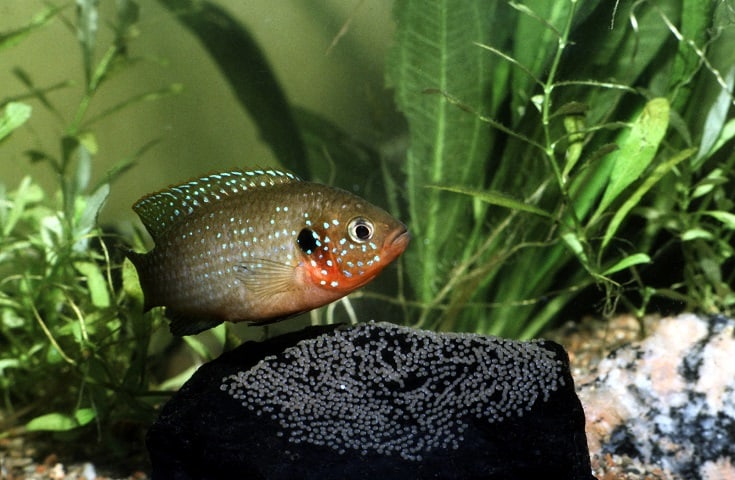
Scientific Name: Hemichromis bimaculatus
Difficulty level: Moderate
Temperament: Aggressive
Tank Size: 30 gallons
Diet: Omnivore
Origin: West Africa
The jewel cichlid is commonly regarded as one of the most colorful cichlids in the world, and for good reason. Though they can be found in a variety of colors, they typically have bright red bodies dotted with iridescent blue flakes.
Their gorgeous appearance belies the fact that they are one of the most aggressive cichlids on this list. These fish are definitely not cut out for community tanks, though their unique behavior and appearance makes them great candidates for dedicated tanks.
14. Jack Dempsey Cichlid
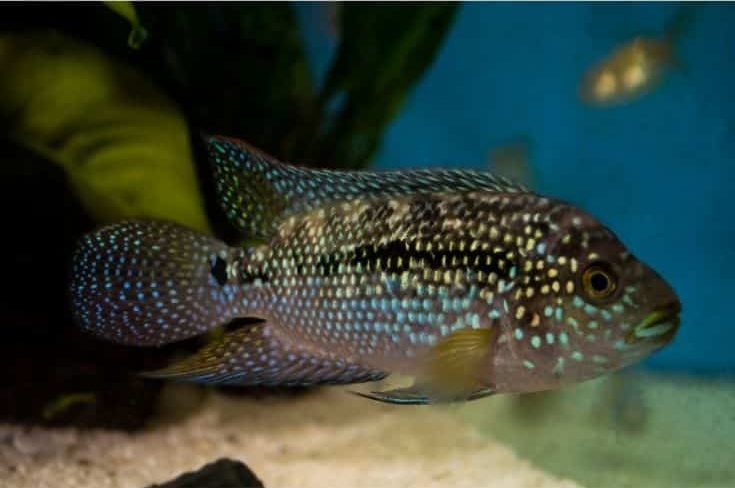
Scientific Name: Rocio octofasciata
Difficulty level: Intermediate
Temperament: Aggressive
Tank Size: 80 gallons
Diet: Carnivore
Origin: Central America
Named after professional boxer Jack Dempsey, these cichlids possess the same aggressive personality and strong build that earned Dempsey his fame.
Jack Dempsey cichlids can grow up to 15 inches long and have a territorial personality, making them inappropriate candidates for community tanks. If you intend to house multiple Jack Dempseys together, make sure to provide adequate space.
On the flip side of their aggressive reputation, Jack Dempseys are intelligent, energetic fish that can provide a lot of entertainment. They are also protective parents who will take good care of their fry.
15. Golden Mbuna
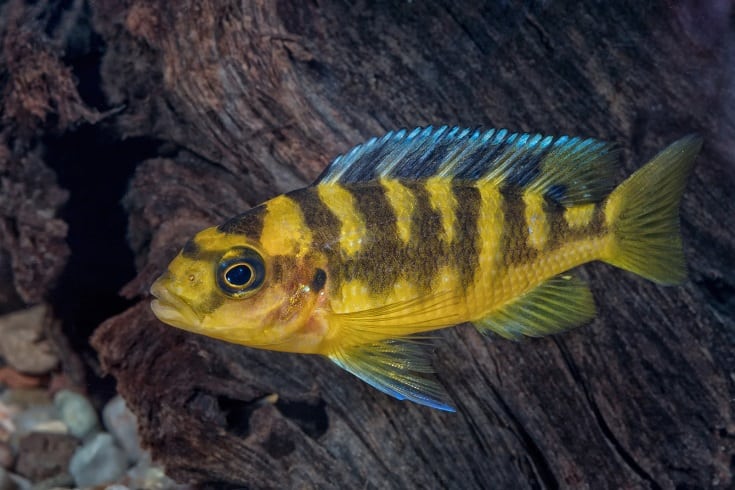
Scientific Name: Melanochromis auratus
Difficulty level: Intermediate
Temperament: Aggressive
Tank Size: 50 gallons
Diet: Omnivore
Origin: Lake Malawi
Though these fish only measure approximately 4 inches in length, Golden Mbunas are one of the more aggressive cichlid species available.
Experienced hobbyists may have some luck housing them in tanks containing other aggressive cichlids, but the general consensus is that these fish are better off in a species-specific tank.
Golden Mbunas are true omnivores and require a good mix of foods rich in protein and plant-based matter. When kept in ideal conditions, they will reward you by being hardy fish that are easy to breed and care for.
16. Bolivian Ram
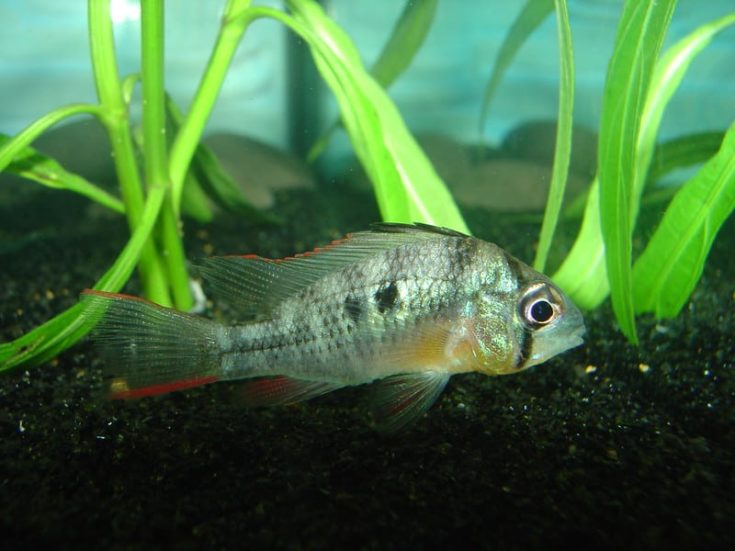
Scientific Name: Mikrogeophagus altispinosus
Difficulty level: Beginner
Temperament: Peaceful
Tank Size: 30 gallons
Diet: Omnivore
Origin: South America
Beginners looking for a peaceful, hardy cichlid should look no further than the Bolivian Ram. These cichlids are great for community aquariums and will do well with tankmates of a similar size, though smaller fish might be mistaken for food.
These fish are perfectly fine living alone or in groups. As is the case with most cichlids, the occasional territorial squabble may occur, though these are usually harmless. Just be sure to house them in adequately-sized tanks, and you’re good to go!
17. Lionhead Cichlid
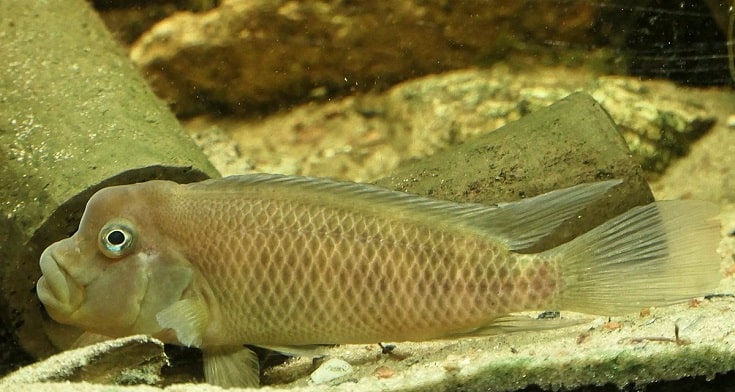
Scientific Name: Steatocranus casuarius
Difficulty level: Beginner
Temperament: Peaceful
Tank Size: 30 gallons
Diet: Omnivore
Origin: Congo River basin, Africa
Sometimes known as the humphead cichlid, male lionhead cichlid feature a distinctive fatty lump on their foreheads.
These fish are known for their strange swimming habits – they hop from spot to spot. This trait developed out of necessity – their natural habitats contained fast-moving streams which were difficult to swim against.
In general, these fish are peaceful and can be kept in community tanks devoid of other bottom-dwelling fish. They enjoy caves, so make sure to line the bottom of your tank with plenty of hiding spaces for these interesting fish!
Cichlid Tank Setup
For the most part, cichlids come from freshwater sources in mainland Africa and tropical America – which makes this guide to caring for freshwater fish a good place to start.
After establishing the basics, there are a few general rules of thumb to keep in mind when creating a tank for freshwater cichlids.
Size
Most cichlids are bottom-dwellers, so it is important to choose a tank that has a large surface area. In addition, cichlids tend to be messy eaters, so pick tanks that are appropriately sized to keep water parameters in check.
Water Parameters
Most cichlids originate from rivers with slow-moving currents, so it is important to replicate these conditions in your tank. In addition, some species might have a preference for harder or softer water depending on their origin.
Substrate
Cichlids love to dig – it’s part of their charm. Therefore, your tank should contain appropriately-sized substrates that fit into the mouths of their cichlid inhabitants. All that digging may uproot your plants, so make sure that you have a well-planted tank!
These tips serve as a general guide to cichlid tanks, but cichlids require aquariums that are catered to their individual needs.
Another factor to consider is that cichlids of different temperaments do well in different settings. Peaceful cichlids make great additions to community tanks, but more territorial cichlids should be kept in species-specific tanks.
Health Issues
The cichlid family is one of the largest in the fishkeeping world, so it’s no surprise when hobbyists find themselves with a sick fish on their hands every once in a while.
The most common illnesses affecting cichlids are ich, swim bladder disease, and hexamita. There are also region-specific illnesses, such as Malawi Bloat, which affect cichlids with roots in Lake Malawi.
A full guide to identifying and treating common cichlid illnesses can be found here, but prevention is often the best form of cure. Make sure that your tank is well-maintained, and provide your fish with their ideal water parameters. It is also good to educate yourself on breed-specific illnesses and precautions you might have to take.
In the unfortunate but all-too-common event that your fish fall ill, act fast. Quickly isolate your sick fish in a separate tank before observing symptoms carefully and providing the appropriate treatment.
With some luck and lots of preparation, you’ll soon have a tank full of healthy, thriving cichlids!
Cichlid Breeding
In general, cichlids are pretty easy to breed. While most cichlids are egg depositors, some cichlid species are mouthbrooding varieties. Egg depositors typically lay their eggs in hidden, protected areas, while mouthbrooders incubate and hatch their eggs in their mouths.
These intriguing breeding habits, coupled with the fact that cichlids require minimal effort to breed, may make it tempting for hobbyists to consider breeding their fish. However, there are a few things to bear in mind:
Designate safe zones for your fry
Fish fry are fragile and require special care, and cichlid fries are no exception.
While mouthbrooders may allow their fry to swim in and out of their mouths for protection, fries hatched from egg depositors require a safe space to grow without being preyed upon by other fish.
To do so, it is recommended that hobbyists use a spare tank to isolate fry from other fish. It is also possible to use a tank divider to create a dedicated area within the same tank for fish fry.
Feed them fry food
It should come as no surprise that fry have dietary needs that are different from their adult counterparts, which is why you should feed them food that has been specially formulated for fish fry.
In addition, you could supplement their diets with live, protein-rich food such as baby brine shrimp.
Be wary of breeding-related aggression
Even if your cichlids are typically calm and peaceful, breeding may cause them to act more aggressively towards their tank mates. For instance, even the typically well-behaved angelfish will act aggressively to defend their breeding spots.
To manage breeding-related aggression, create ample hiding spaces for your cichlids. Research the different types of breeding spots preferred by different types of cichlids and be sure to make those spots widely available in your tank.
A bonded pair may sometimes act aggressively towards one another. In these cases, you might need to consider separating the aggressor using a tank divider. This allows the pair to remain in each other’s presence without hurting one another.
Having covered some basics on how to keep your cichlids happy, here are some exciting cichlids you should consider adding to your tank!
Conclusion
Cichlids are a diverse group of fish that will brighten up any tank. Whether you’re a beginner looking for a low-maintenance community fish, or a cichlid enthusiast selecting your next candidate for a species-specific tank, there’s a cichlid out there for you.
Caring for these fish is a lot of fun – keep your tank clean and your water parameters stable, and your cichlids will reward you by showing off their interesting quirks and personality!
